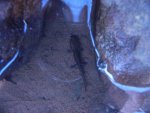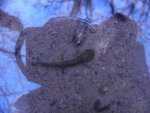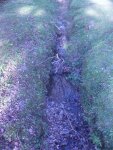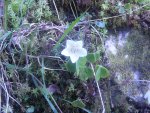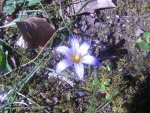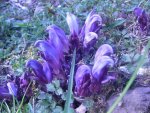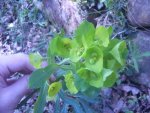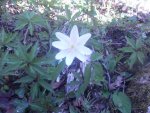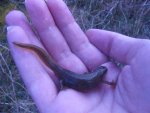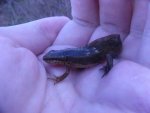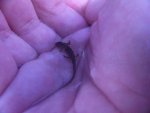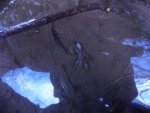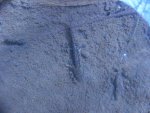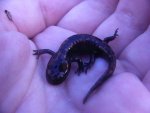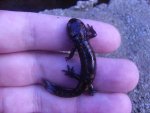Azhael
Site Contributor
- Joined
- May 7, 2007
- Messages
- 6,644
- Reaction score
- 121
- Points
- 0
- Location
- Burgos
- Country
- Spain
- Display Name
- Rodrigo
It had been about a year and a half since the last time i could go herping, and i was dying to.
So, finally, the time had arrived, i had the opportunity to satisfy my thirst for nature and i had two days to do so. So the first day i decided to go to one of my favourite spots. This place is the clossest thing to heaven for me, it´s just gorgeous and lush. Well...it usually is...
The place is a valley covered by typical european mixed forest (mainly beech, but also chestnut, oak, hazelnut, holly...). As such, it´s usually very damp and lush with endless green carpets of moss. It´s prime territory for L.helveticus alonsoi and S.s.fastuosa (the place is a famous location and many european herpers visit it).
This year, although the rest of Spain has had a very humid and rainy winter, Cantabria (northern spain) which is isolated by a large mountain range, has received and unusually low amount of rain during february and march, apparently because all the rain came from the south (we all know what´s been happening in the Azores). The valley where i went herping appears to have been one of the places with worst luck, and you could really see that everything was waaaay too dry.
As a result of the unusual drought, the main river and the adyacent streams had not overflown this year, which means that there were no side pools and flooded areas, which are precisely what the local caudates use. The moss carpets were bone dry and broke when touched, the leaf litter rustled..it was obvious there had been a serious lack of water in a place that is usually dripping year-round.
Anyway, after two hours of searching in spots that i know for a fact that normally contain a good number of adult L.helveticus and many S.s.fastuosa larvae (i´ve been visiting the place for well over a decade, so i know where to look), i had found nothing...absolutely nothing. I was desperate...more so since i hadn´t seen a single Rana temporaria which are locally very abundant. When you don´t see them, something is seriously wrong.
In the end, just when i was returning to the car, i decided to give a good, thorough check to a tiny little stream (if that can be called a stream) where every year there are lots of S.s.fastuosa larvae. In one of the wee pockets of water (about the width of a hand), in a good year you can find as many as 16 larvae. I new that if i didn´t find something there i wouldn´t find anything at all no matter how hard i tried.
Thankfully there were a few larvae, but in a good few meters and several pockets of water i only managed to find 5 larvae!!!
When i got to the car my father told me that he had found tadpoles, so i went and checked. There were a couple dozen R.temporaria in a road pool. The ONLY tadpoles that i managed to see.
Ok, so enough blabbering, sorry for the long speech xD Here are a couple of pics of the S.s.fastuosa larvae and lacking anything better, a few shots of the local spring flowers (which by the way where and absolute joy in an otherwise sad day) some of which i can´t identify, sorry.
Pictures:
-nº1, nº2: S.s.fastuosa larva
-nº3: The "stream".
-nº4: Oxalis acetosella
-nº5: I think Crocus.sp
-nº6: Parasitic plant (i wish i had my Bonnier)
-nº7: Euphorbiaceae (no idea of the species)
-nº8: Anemone nemorosa
So, finally, the time had arrived, i had the opportunity to satisfy my thirst for nature and i had two days to do so. So the first day i decided to go to one of my favourite spots. This place is the clossest thing to heaven for me, it´s just gorgeous and lush. Well...it usually is...
The place is a valley covered by typical european mixed forest (mainly beech, but also chestnut, oak, hazelnut, holly...). As such, it´s usually very damp and lush with endless green carpets of moss. It´s prime territory for L.helveticus alonsoi and S.s.fastuosa (the place is a famous location and many european herpers visit it).
This year, although the rest of Spain has had a very humid and rainy winter, Cantabria (northern spain) which is isolated by a large mountain range, has received and unusually low amount of rain during february and march, apparently because all the rain came from the south (we all know what´s been happening in the Azores). The valley where i went herping appears to have been one of the places with worst luck, and you could really see that everything was waaaay too dry.
As a result of the unusual drought, the main river and the adyacent streams had not overflown this year, which means that there were no side pools and flooded areas, which are precisely what the local caudates use. The moss carpets were bone dry and broke when touched, the leaf litter rustled..it was obvious there had been a serious lack of water in a place that is usually dripping year-round.
Anyway, after two hours of searching in spots that i know for a fact that normally contain a good number of adult L.helveticus and many S.s.fastuosa larvae (i´ve been visiting the place for well over a decade, so i know where to look), i had found nothing...absolutely nothing. I was desperate...more so since i hadn´t seen a single Rana temporaria which are locally very abundant. When you don´t see them, something is seriously wrong.
In the end, just when i was returning to the car, i decided to give a good, thorough check to a tiny little stream (if that can be called a stream) where every year there are lots of S.s.fastuosa larvae. In one of the wee pockets of water (about the width of a hand), in a good year you can find as many as 16 larvae. I new that if i didn´t find something there i wouldn´t find anything at all no matter how hard i tried.
Thankfully there were a few larvae, but in a good few meters and several pockets of water i only managed to find 5 larvae!!!
When i got to the car my father told me that he had found tadpoles, so i went and checked. There were a couple dozen R.temporaria in a road pool. The ONLY tadpoles that i managed to see.
Ok, so enough blabbering, sorry for the long speech xD Here are a couple of pics of the S.s.fastuosa larvae and lacking anything better, a few shots of the local spring flowers (which by the way where and absolute joy in an otherwise sad day) some of which i can´t identify, sorry.
Pictures:
-nº1, nº2: S.s.fastuosa larva
-nº3: The "stream".
-nº4: Oxalis acetosella
-nº5: I think Crocus.sp
-nº6: Parasitic plant (i wish i had my Bonnier)
-nº7: Euphorbiaceae (no idea of the species)
-nº8: Anemone nemorosa
Attachments
Last edited:

